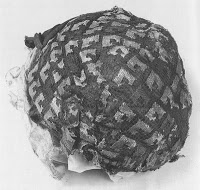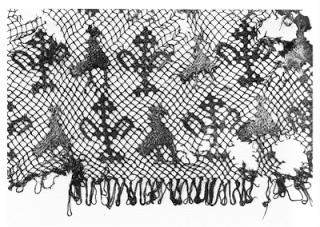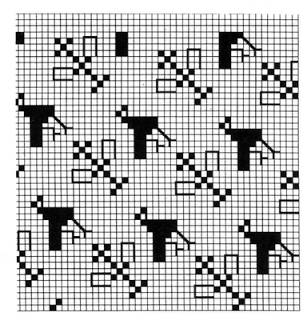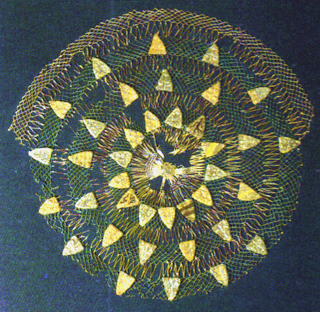Here's a picture of the current status of the hairnet I'm working on. Only about three centimeters left to net, hooray!

Picture clickable for larger view
As you can possibly see (the photos are not that good), the net is worked in a spiral. The spiralling approach has its advantages, but also a fair share of disadvantages, in my opinon.
I like the fact that, when spiralling, you can just go on and on with netting. Once the spiral is properly established, there is no need to fiddle with the mesh size for the transit into the next row, there are no double threads or new knottings-in for this transition, just netting same size endlessly.
What I don't like is that you will get distortions in the first few rows, until the spiral is smoothed out. That can be achieved either by slowly lengthening the cast-on loops so that the first normal-sized meshes don't stick out so much, or by fiddling a bit with the mesh size in the first rows. And the finish of the net is, of course, also a spiral and will need some more fiddling to look smooth and well-rounded.
Spiral netting is also not too well suited to colour changes in the netting - exactly what I did in this piece, just because I felt like using two colours. Where the colour change is, you always get an abrupt change in one of the percieved "rows", and I think it looks a bit sloppy, or disorganized. It is technically not possible to change this when working spirals; there is no sudden change in one row when working circular. So for multicoloured nets, circular might be better.
And the last thing I don't like now that I'm nearing the end: There are no rows, and hence, there is no feeling of accomplishment on finishing a row. What can be seen as an asset of spiral netting - not needing to transit between rows - can feel tedious. I know that I need about 6 or 7 more rounds in the spiral, but it is awfully hard to keep track how much I have netted in one session.
Taking all this together, I personally feel that netting in the circular would be more appropriate for what I'm trying to get, while netting in the spiral might be the best way for a beginner to make a nice practice piece, only needing to concentrate on the act of netting nice even meshes. Therèse de Dillmont doesn't give instructions for spiral netting; her circular netting "recipe" says to knot in anew for every next row.
After this last stint of spiral netting, I'm not so sure whether it was used as an approach for net-making in the middle ages. It would be interesting to look at some of the extant nets in detail to see whether there is a shortened transit mesh or new knotting in of the thread for the next row, or if there are actually nets worked in the spiral.
The last picture shows the size of the meshes in the net, with the net laid out on a normal 5 mm grid paper. Sorry for the bad quality of the picture.

You can see that the mesh size is approximately 4 mm. I think this is a nice size, still easy to work with a fairly sturdy netting needle, within the size spectrum of medieval hairnets and not so small-meshed that it would take ages to do it. However, netting is not a fast craft, and even with this mesh size, it will take its time. Practice speeds the knotting a bit, but there's a limit to how fast your hands can go. I'll give the exact time needed when I'm all finished with the net, but by now it has taken more than 25 hours.

As you can possibly see (the photos are not that good), the net is worked in a spiral. The spiralling approach has its advantages, but also a fair share of disadvantages, in my opinon.
I like the fact that, when spiralling, you can just go on and on with netting. Once the spiral is properly established, there is no need to fiddle with the mesh size for the transit into the next row, there are no double threads or new knottings-in for this transition, just netting same size endlessly.
What I don't like is that you will get distortions in the first few rows, until the spiral is smoothed out. That can be achieved either by slowly lengthening the cast-on loops so that the first normal-sized meshes don't stick out so much, or by fiddling a bit with the mesh size in the first rows. And the finish of the net is, of course, also a spiral and will need some more fiddling to look smooth and well-rounded.
Spiral netting is also not too well suited to colour changes in the netting - exactly what I did in this piece, just because I felt like using two colours. Where the colour change is, you always get an abrupt change in one of the percieved "rows", and I think it looks a bit sloppy, or disorganized. It is technically not possible to change this when working spirals; there is no sudden change in one row when working circular. So for multicoloured nets, circular might be better.
And the last thing I don't like now that I'm nearing the end: There are no rows, and hence, there is no feeling of accomplishment on finishing a row. What can be seen as an asset of spiral netting - not needing to transit between rows - can feel tedious. I know that I need about 6 or 7 more rounds in the spiral, but it is awfully hard to keep track how much I have netted in one session.
Taking all this together, I personally feel that netting in the circular would be more appropriate for what I'm trying to get, while netting in the spiral might be the best way for a beginner to make a nice practice piece, only needing to concentrate on the act of netting nice even meshes. Therèse de Dillmont doesn't give instructions for spiral netting; her circular netting "recipe" says to knot in anew for every next row.
After this last stint of spiral netting, I'm not so sure whether it was used as an approach for net-making in the middle ages. It would be interesting to look at some of the extant nets in detail to see whether there is a shortened transit mesh or new knotting in of the thread for the next row, or if there are actually nets worked in the spiral.
The last picture shows the size of the meshes in the net, with the net laid out on a normal 5 mm grid paper. Sorry for the bad quality of the picture.

You can see that the mesh size is approximately 4 mm. I think this is a nice size, still easy to work with a fairly sturdy netting needle, within the size spectrum of medieval hairnets and not so small-meshed that it would take ages to do it. However, netting is not a fast craft, and even with this mesh size, it will take its time. Practice speeds the knotting a bit, but there's a limit to how fast your hands can go. I'll give the exact time needed when I'm all finished with the net, but by now it has taken more than 25 hours.







